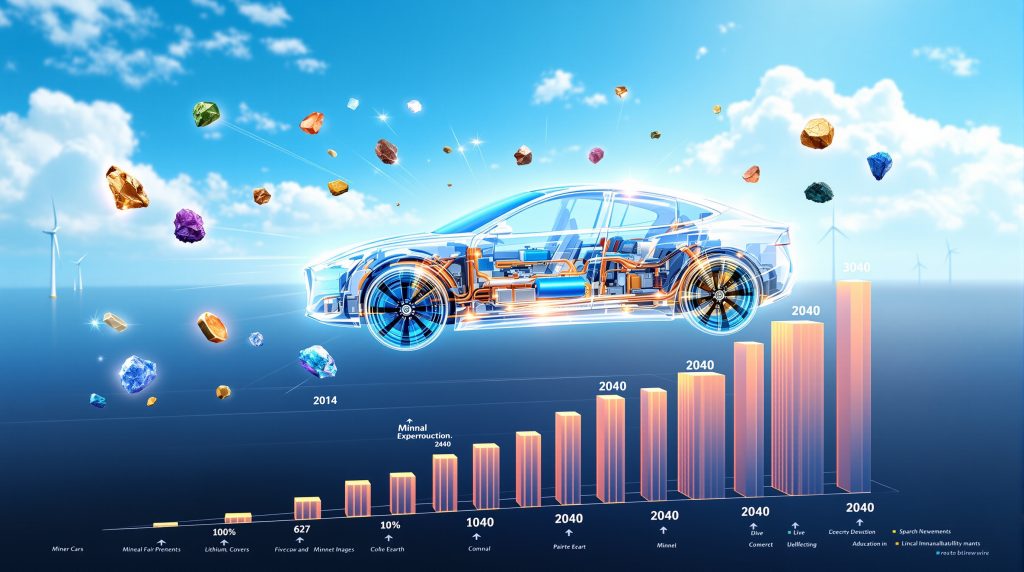What Would an Electric Car Look Like Without Any Mining Materials?
The concept of an electric car without mining materials sounds like an environmental dream, but the reality reveals just how dependent modern transportation is on extracted resources. Sandvik's innovative eNimon vehicle demonstrates this dependency in the most striking way possible: by creating a completely transparent, non-functional electric car that contains zero metals or minerals.
The Reality Behind Mining-Free Electric Vehicles
The eNimon, currently displayed at the National Museum of Science and Technology in Stockholm, Sweden, serves as a powerful visual reminder of what's truly at stake in the green energy transition. This transparent vehicle cannot move, cannot store energy, and lacks every functional component that makes an electric car operational. The reason is simple: more than 90% of electric vehicle components come from mined materials.
Without access to lithium for batteries, copper for wiring, rare earth elements for motors, or steel for structural components, the eNimon exists purely as a conceptual framework. Its see-through design isn't a futuristic aesthetic choice but rather a necessity born from the absence of any substantial materials.
Understanding the eNimon Concept Vehicle's Message
Mats Eriksson, President of Business Area Mining at Sandvik, emphasizes that sustainable mining is the backbone of the green transition. Without mining operations, climate goals become impossible to achieve. The eNimon vehicle crystallizes this message by demonstrating that there wouldn't be a green transition without mining.
Furthermore, the vehicle's transparent appearance and complete lack of functionality serve as a stark reminder that current alternatives to mined materials simply don't exist at the scale or performance levels required for modern electric vehicles. This conceptual car forces viewers to confront the fundamental relationship between environmental sustainability and responsible resource extraction.
Why Electric Vehicles Currently Cannot Exist Without Mining
The dependency of electric vehicles on mining operations extends far beyond simple material requirements. Every critical system in an EV relies on extracted minerals, creating an intricate web of geological necessity that current technology cannot circumvent.
Critical Minerals Required for EV Battery Production
Electric vehicles demand approximately six times more minerals than conventional vehicles, highlighting the intensive material requirements of clean transportation technology. This dramatic increase stems from the sophisticated battery systems, electric motors, and advanced electronics that replace traditional combustion engines.
| Material | Primary Function | Critical Applications |
|---|---|---|
| Lithium | Energy storage | Battery cathodes, electrolytes |
| Cobalt | Battery stability | Thermal management, cycle life |
| Nickel | Energy density | High-performance cathodes |
| Copper | Electrical conductivity | Wiring, motors, charging systems |
| Rare Earth Elements | Magnetic properties | Permanent magnets, motor efficiency |
Each of these materials serves irreplaceable functions in current EV technology. Lithium enables the electrochemical reactions that store and release energy in batteries. Cobalt prevents dangerous thermal runaway conditions that could lead to battery fires. Nickel increases energy density, allowing vehicles to travel further on a single charge. Copper provides the electrical conductivity essential for power transmission throughout the vehicle.
Quantifying Mining Dependency in Modern EVs
The scale of mining dependency becomes even more apparent when considering the broader renewable energy infrastructure. Wind farms require approximately nine times more materials than gas plants, while reaching net zero by 2050 demands up to five times more lithium, nickel, and cobalt than current production levels.
Modern underground mining operations are becoming invisible, autonomous, electrified, and digitized to meet the unprecedented demand for critical minerals in the green energy transition.
This material intensity isn't a design flaw but rather a fundamental characteristic of energy storage and conversion technologies. The physics of electricity storage and transmission require specific materials with unique properties that cannot be easily substituted or eliminated entirely.
How Much Mining Does the Green Energy Transition Actually Require?
The scope of mining required for global decarbonization efforts reaches unprecedented levels, fundamentally reshaping the relationship between environmental goals and resource extraction industries. However, digital mining operations are increasingly optimising these processes to meet demand efficiently.
Global Mineral Demand Projections Through 2040
The International Energy Agency forecasts transformational changes in mineral demand over the next two decades. Global demand for critical minerals will triple by 2030 and quadruple by 2040, representing one of the most significant resource mobilization efforts in human history.
| Timeline | Demand Increase | Key Drivers |
|---|---|---|
| 2030 | 3x current levels | EV adoption, renewable deployment |
| 2040 | 4x current levels | Grid storage, infrastructure expansion |
| Total Volume | 3+ billion tonnes | Wind, solar, energy storage systems |
This massive scaling requirement encompasses the entire renewable energy ecosystem. The 3+ billion tonnes of minerals and metals needed includes materials for wind turbine construction, solar panel manufacturing, grid-scale energy storage systems, and the millions of electric vehicles required to decarbonise transportation.
Wind and Solar Infrastructure Mining Requirements
Renewable energy infrastructure demonstrates mining intensity that often surprises environmental advocates. Wind turbines require substantial quantities of rare earth elements for their permanent magnet generators, while solar panels depend on silicon purification processes and specialised metals for electrical components.
Moreover, the renewable energy sector's material demands extend beyond the generating equipment itself. Grid infrastructure upgrades, energy storage installations, and electric vehicle charging networks all require extensive mining outputs to support the transition away from fossil fuels.
What Sustainable Alternatives Are Being Developed to Reduce Mining Dependency?
While the mining industry adapts to meet unprecedented demand, researchers and manufacturers explore various approaches to reduce the overall material intensity of clean energy technologies. Additionally, mining innovation trends are continuously evolving to address these challenges.
Advanced Battery Recycling Technologies
Battery recycling represents one of the most promising pathways to reduce new mining requirements. Closed-loop material recovery systems aim to capture lithium, cobalt, nickel, and other valuable elements from end-of-life batteries for reuse in new energy storage systems. The recent battery recycling breakthrough demonstrates significant progress in this area.
Current recycling processes typically involve:
• Mechanical processing to separate battery components
• Pyrometallurgical treatment to recover metal content
• Hydrometallurgical extraction for high-purity material recovery
• Direct recycling to preserve cathode structure and composition
However, recycling alone cannot meet the growing demand for battery materials. The rapid expansion of EV production means that recycled content will supplement rather than replace primary mining for the foreseeable future.
Cobalt-Free Battery Innovation
Cobalt reduction efforts focus on alternative cathode chemistries that maintain performance while reducing dependency on this geographically concentrated mineral. Lithium iron phosphate (LFP) batteries have gained significant market share in certain vehicle segments, offering improved safety characteristics and lower material costs.
These cobalt-free alternatives provide several advantages:
• Enhanced thermal stability and safety margins
• Reduced supply chain complexity and geopolitical risk
• Lower raw material costs for battery manufacturers
• Simplified recycling processes at end-of-life
However, cobalt-free batteries typically offer lower energy density, resulting in reduced vehicle range or larger battery pack requirements to maintain performance standards.
Bio-Composite and Recycled Materials Integration
Vehicle manufacturers increasingly incorporate sustainable materials in non-critical components. Bio-composite materials derived from natural fibres can replace traditional plastics in interior components, while recycled aluminium and steel reduce the need for primary metal production.
Plant-based alternatives show promise for specific applications:
• Natural fibre composites for interior panels and trim
• Bio-based plastics for non-structural components
• Recycled carbon fibre for lightweight structural applications
• Sustainable textiles for seating and interior surfaces
Can Smart Mining Technologies Make Electric Cars More Sustainable?
Modern mining operations increasingly rely on digital technologies and automation to improve efficiency whilst reducing environmental impact. These technological advances offer pathways to extract required materials more responsibly.
Digital Mining Operations and Efficiency Gains
According to Sandvik's latest innovations, contemporary underground operations optimise themselves in real-time through continuous data collection, improving productivity and cutting energy use per tonne extracted. Battery-electric loaders, trucks, and drills coordinate through advanced software systems, reducing the need for personnel at extraction faces.
Digital tools provide live, system-wide views that allow operators to fine-tune:
• Blasting patterns for optimal rock fragmentation
• Haulage routing for maximum efficiency
• Ventilation systems for air quality management
• Maintenance scheduling for equipment optimisation
The result is higher throughput with fewer interruptions and a smaller environmental footprint. Autonomous fleets can operate in deeper and harsher conditions without exposing workers to safety risks.
Environmental Impact Reduction Through Technology
Smart mining technologies demonstrate measurable improvements across multiple environmental metrics. Collision-avoidance systems, remote operation capabilities, and condition monitoring reduce operational risks whilst improving resource extraction efficiency.
| Parameter | Traditional Mining | Smart Mining | Improvement |
|---|---|---|---|
| Energy per tonne | Baseline consumption | Optimised real-time | Reduced consumption |
| Water usage | Fixed system operation | Recycled and monitored | Efficiency gains |
| Land disturbance | Standard footprint | Precision extraction | Minimised impact |
| Safety incidents | Human-operated risk | Autonomous operation | Risk reduction |
These advances focus on mining smarter rather than simply extracting more material, aligning extraction activities with the environmental goals that drive demand for critical minerals.
What Are the Biggest Challenges Facing Mining-Free Electric Vehicle Development?
Despite significant research investments, fundamental technical and economic barriers prevent the complete elimination of mining from electric vehicle production. Furthermore, industry experts worry about the implications of deep-sea mining concerns as demand for critical minerals increases.
Technical Limitations of Current Alternatives
The physics of energy storage and electrical conductivity impose strict material requirements that current alternatives cannot meet at commercial scale. Energy density constraints without lithium severely limit vehicle range and performance capabilities.
Key technical challenges include:
• Energy density gaps between lithium-ion and alternative battery chemistries
• Conductivity requirements that only copper can efficiently provide
• Magnetic strength needs for motor efficiency that require rare earth elements
• Structural integrity demands that necessitate steel and aluminium components
Economic Barriers to Alternative Material Adoption
Research and development costs for mining-free alternatives require substantial investment with uncertain commercial outcomes. Scale-up manufacturing challenges compound these economic barriers, as alternative materials often require entirely new production infrastructure.
The economic reality includes:
• High R&D costs for unproven technologies
• Manufacturing scale requirements for cost competitiveness
• Supply chain infrastructure development needs
• Performance trade-offs that may reduce market acceptance
How Close Are We to Significantly Reducing EV Mining Requirements?
While complete elimination of mining from electric vehicle production remains impractical, several emerging technologies offer potential for meaningful reductions in material intensity over the coming decades. Additionally, tech analysis of mining-free vehicles suggests that such concepts remain largely theoretical at present.
Breakthrough Technologies on the Horizon
Solid-state battery technology represents one of the most promising developments for reducing material requirements per unit of energy storage. These batteries potentially offer higher energy density with simplified material compositions, though commercial viability remains several years away.
Sodium-ion batteries provide another avenue for reducing lithium dependency, utilising abundant sodium resources instead of geographically concentrated lithium deposits. However, energy density limitations currently restrict their application to specific market segments.
Research into organic battery technologies explores carbon-based energy storage systems that could theoretically reduce mining requirements, though these technologies remain in early experimental stages.
Industry Timeline for Mining Reduction
Realistic projections for material efficiency improvements suggest gradual rather than revolutionary changes in mining requirements. Regulatory drivers accelerating innovation include emissions standards, recycling mandates, and supply chain transparency requirements.
The path to reduced mining dependency relies on incremental improvements across multiple technologies rather than single breakthrough solutions.
Current industry consensus indicates that meaningful reductions in mining intensity will occur over decades rather than years, with recycling and efficiency improvements providing the most immediate opportunities for progress.
What Role Does Responsible Mining Play in Sustainable Electric Vehicles?
Rather than eliminating mining entirely, the focus shifts toward developing extraction practices that align with environmental and social sustainability goals whilst meeting the material demands of decarbonisation. Consequently, sustainable mining practices are becoming increasingly important for the industry.
Sustainable Mining Practices and Standards
Environmental certification programmes increasingly govern mining operations, establishing standards for water management, biodiversity protection, and community engagement. Transparency in supply chains allows consumers and manufacturers to make informed decisions about material sourcing.
Key sustainability standards include:
• Environmental impact assessments for new mining projects
• Community engagement requirements for local stakeholder involvement
• Water management protocols for ecosystem protection
• Biodiversity conservation measures for sensitive areas
Circular Economy Approaches in EV Manufacturing
Design for recyclability principles guide modern EV development, ensuring that vehicles can be efficiently disassembled and materials recovered at end-of-life. Extended producer responsibility models place recycling obligations on manufacturers rather than consumers.
Up to 90% of EV materials could potentially be recoverable through advanced recycling and remanufacturing processes.
Circular economy strategies encompass the entire vehicle lifecycle, from material extraction through manufacturing, use, and eventual recycling or remanufacturing into new products.
Frequently Asked Questions About Mining-Free Electric Cars
Is a completely mining-free electric car possible?
Current technology makes completely mining-free electric cars impossible whilst maintaining functionality. The eNimon concept vehicle demonstrates this reality by showing that removing all mined materials results in a transparent, non-operational vehicle. Essential components like batteries, motors, and electrical systems require specific materials that currently have no viable mining-free alternatives.
What materials in EVs absolutely require mining?
Several materials remain irreplaceable in current EV technology. Lithium provides the electrochemical properties essential for battery energy storage. Copper offers unmatched electrical conductivity for wiring and motors. Rare earth elements create the powerful permanent magnets necessary for efficient electric motors. Steel and aluminium provide the structural integrity required for vehicle safety.
How much can recycling reduce new mining needs?
Battery recycling can potentially recover up to 95% of lithium, cobalt, and nickel from end-of-life vehicles. However, the rapid growth in EV production means recycled materials will supplement rather than replace primary mining for several decades. Current recycling infrastructure handles only a fraction of the materials entering the market annually.
Which EV components use the most mined materials?
The battery pack contains the highest concentration of mined materials, representing approximately 40% of the vehicle's total mineral content. Electric motors require significant quantities of rare earth elements and copper. The vehicle's structural components, wiring harnesses, and electronic systems account for the remaining mined material requirements.
The Future of Electric Vehicles and Mining Sustainability
The relationship between electric vehicles and mining will evolve toward greater efficiency and responsibility rather than complete separation. This evolution requires balancing decarbonisation goals with sustainable resource extraction practices.
Balancing Decarbonisation Goals with Resource Extraction
Lifecycle assessment considerations demonstrate that electric vehicles provide net environmental benefits despite their mining requirements. The carbon footprint of material extraction and battery production is offset by zero-emission operation over the vehicle's lifespan.
Net environmental benefit calculations must account for:
• Manufacturing emissions from material extraction and processing
• Operational emissions from electricity generation for charging
• End-of-life recovery through recycling and remanufacturing
• Avoided emissions from displaced fossil fuel consumption
Investment Opportunities in Mining Alternatives
Venture capital trends show increasing investment in material innovation, recycling technologies, and alternative battery chemistries. Government funding for research initiatives supports long-term development of mining-reduction technologies whilst maintaining clean energy deployment momentum.
The electric car without mining remains a conceptual goal rather than a near-term reality. However, the pursuit of this objective drives innovation in sustainable materials, recycling technologies, and responsible mining practices that collectively reduce the environmental impact of clean transportation. The eNimon vehicle serves as a powerful reminder that current environmental goals depend on the responsible development of mineral resources, making sustainable mining practices essential to the green energy transition.
Disclaimer: This article contains projections and analysis based on current industry trends and research. Future technological developments may alter the timeline and feasibility of reducing mining requirements in electric vehicles. Readers should consider multiple sources when making investment or purchasing decisions related to clean energy technologies.
Looking for Investment Opportunities in Critical Minerals?
Discovery Alert identifies significant ASX mineral discoveries the moment they're announced, powered by its proprietary Discovery IQ model that transforms complex geological data into immediate trading insights. With the green energy transition requiring unprecedented quantities of lithium, cobalt, nickel, and rare earth elements, Discovery Alert's discoveries page showcases how major mineral finds have historically generated substantial returns for early investors.




